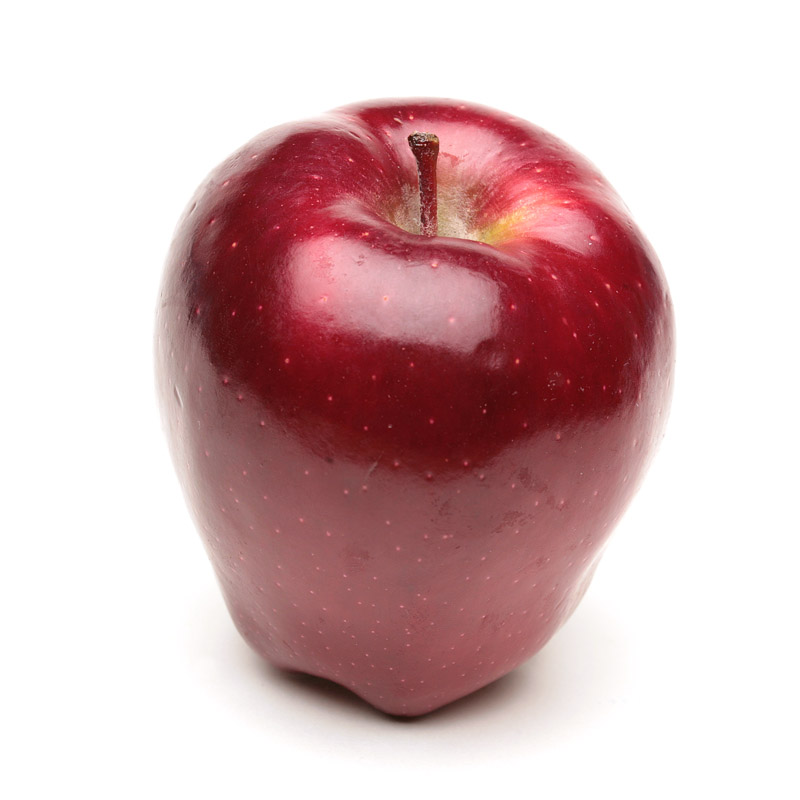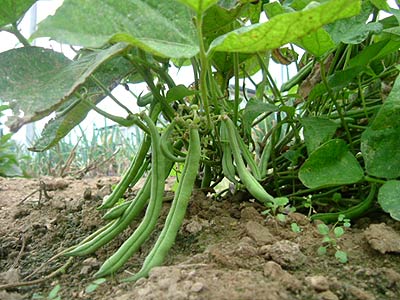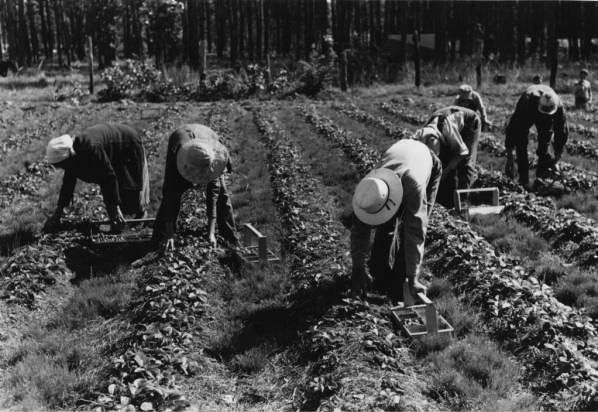Showing posts with label industrial ag. Show all posts
Showing posts with label industrial ag. Show all posts
Sunday, October 2, 2011
California Almonds
I recently got a tour of some Cali Central Valley almond farms from the Almond Doctor.
The nuts were in the process of being harvested. The first step is to shake the nuts off the tree with a machine that grabs them around the trunk (here's a video*). One way you can tell almond and peach (both Prunus species) orchards apart is to look at how low the first branches are. Almond trees are trained to branch higher above the ground to give the machine room to grab them. Peach trees are trained to branch almost immediately above the ground to help most of the canopy stay low enough to be reached without ladders (due to the increased chance of injuries). Maximum canopy height is more rigorously limited in peaches for the same reason.
Wednesday, September 21, 2011
Polycultures in Modern Ag?
The September issue of CSA news has a nice (open access) article entitled: "Do polycultures have a role in modern agriculture?"
Some key caveats:
Thoughts?
Some key caveats:
They conclude that polycultures are intriguing but definitely require more (agronomically realistic) research.
- While diverse plant mixtures have been associated with many benefits, high biomass yield (i.e. what farmers get paid for) is usually not one of them.
- It's very difficult to maintain complex plant mixtures - usually a single species will come to dominate.
- Our crop monocultures represent those crops that are best adapted to a given region.
- Establishing, maintaing and harvesting polycultures will require significant effort, risk, investments and training for farmers.
Thoughts?
Monday, August 8, 2011
Putting up Hay
It used to be a common sight for me this time of year (on the way to the maize experimental fields) to see straw and hay being raked into windrows by hay rakes (video 1 2). Though most of us tend to use these words interchangeably, hay is a crop grown specifically for animal feed and straw is the leftover stems and leaves of a harvested grain that may be used for animal feed, bedding or construction. Common annual and perennial hay crops include legumes (e.g. alfalfa and clover) and grasses (e.g. timothy, brome, orchard grass and tall fescue). Straw usually comes from whatever grain is being grown in your area (e.g. wheat or barley).
Friday, May 13, 2011
Commercial Perennial Crops?
The "perennial grain" story seems to pop up every few months. The basic idea is that perennial crops would have higher yields and lower environmental impacts than their annual kin.
The picture on the left explains pretty clearly why - large permanent root systems secure the topsoil, exhaustively scavenge water and nutrients and support more vigorous shoot growth over a longer season.
This week, it's perennial maize.
The picture on the left explains pretty clearly why - large permanent root systems secure the topsoil, exhaustively scavenge water and nutrients and support more vigorous shoot growth over a longer season.
This week, it's perennial maize.
Tuesday, March 8, 2011
Plastic-Wrapped Bananas Not So Crazy?
The Daily Show ran a very funny bit on Del Monte's new single serving, plastic wrapped bananas the other night. Though they might not be as crazy as they sound...
h/t: Daily Mail:
These bananas, intended to be sold at convenience stores and gas stations, are wrapped in bags containing "Controlled Ripening Technology" (some sort of ethylene inhibitor?) that is said to extend shelf life up to 6 days. The bananas are placed in their bags while green and ripen more slowly than those piled on the shelf. They're being marketed as 'Natural Energy Snack on the Go,' for a U.S. cost of $1 each. 7-Eleven enthusiastically adopted these single serving bananas in thousands of stores last year due to customer disdain for brown bananas and the fewer (carbon/cost-intensive) deliveries that are required to stock produce with an extended shelf life.
It's also been pointed out that getting fresh, (culturally?)-appealing produce into quickie marts and bodegas in inner cities and isolated small towns might do more good alleviating food deserts than it does harm in generating extra trash.
h/t: Daily Mail:
These bananas, intended to be sold at convenience stores and gas stations, are wrapped in bags containing "Controlled Ripening Technology" (some sort of ethylene inhibitor?) that is said to extend shelf life up to 6 days. The bananas are placed in their bags while green and ripen more slowly than those piled on the shelf. They're being marketed as 'Natural Energy Snack on the Go,' for a U.S. cost of $1 each. 7-Eleven enthusiastically adopted these single serving bananas in thousands of stores last year due to customer disdain for brown bananas and the fewer (carbon/cost-intensive) deliveries that are required to stock produce with an extended shelf life.
It's also been pointed out that getting fresh, (culturally?)-appealing produce into quickie marts and bodegas in inner cities and isolated small towns might do more good alleviating food deserts than it does harm in generating extra trash.
Sunday, February 27, 2011
Transgenic Papayas, Take 2
I must have been busy last year when Genomic Gastronomy tried to engage my post on transgenic papaya because I didn't really give much of an answer...
So with apologies, here's more!
So with apologies, here's more!
Saturday, February 26, 2011
Saturday, February 19, 2011
GM Vegetable Oil
Hooray for Seed Today helping me to clear another story out of my "drafts" folder!
How GM Overcame Soy's Fatal Flaw
It's an exciting time in genetic engineering! I've long been bored by the simplicity of our contemporary transgenic crops and the single-minded focus on agronomic traits. Dropping in an herbicide or pest resistance gene is good for the environment and the farmer, but it doesn't visibly benefit the consumer very much and just doesn't impress me technically. Now, Monsanto and Pioneer's new soybean varieties are heralding a new era of more sophisticated metabolic engineering of traits that will directly benefit the public.
How GM Overcame Soy's Fatal Flaw
It's an exciting time in genetic engineering! I've long been bored by the simplicity of our contemporary transgenic crops and the single-minded focus on agronomic traits. Dropping in an herbicide or pest resistance gene is good for the environment and the farmer, but it doesn't visibly benefit the consumer very much and just doesn't impress me technically. Now, Monsanto and Pioneer's new soybean varieties are heralding a new era of more sophisticated metabolic engineering of traits that will directly benefit the public.
Thursday, December 2, 2010
Maize is a Machine
This is why farmers like hybrid seed. The parents on the left and right are inbred lines that have been self-pollinated for many, many years.* The two rows of much bigger plants in the middle are simply their hybrid offspring - they grow faster, produce higher yields and are tougher in the face of unfriendly environments.
Saturday, November 20, 2010
The Nutrition-Industrial Complex
"cheez-its are not nearly as good as generic cheez-its,"
I posted on Facebook.
Dennis suggested I had bought low-sodium ones - though I was sure it was due to the presence of "real cheese" in the generic.
I posted on Facebook.
Dennis suggested I had bought low-sodium ones - though I was sure it was due to the presence of "real cheese" in the generic.
Wednesday, November 3, 2010
They took our jobs!
Mexican citizens may or may not be underbidding (and forcing down wages of) American jobs in the construction and service industries but they are definitely not taking U.S. farm worker jobs, as anyone in the agricultural sector can tell you.
Sunday, September 26, 2010
Tuesday, September 21, 2010
Farm Blogs + Trade Mags
I just heard an NPR bit on an effort to establish a tea farm in California (Davis adjacent!). They have a blog too.
While I'm at it, here are some other cool farm blogs I've come across recently:
A Day in the Life of a Farm Vet...
Adventures in Agriculture
Agriculture Proud
Food for Thought
Griggs Dakota
Martin Family Farms
Shedding Light on Agriculture
Sitting in the Pasture...
Slow Money Farms
Starving off the Land
h/t: many from JP Loves Cotton
While I'm at it, here are some other cool farm blogs I've come across recently:
A Day in the Life of a Farm Vet...
Adventures in Agriculture
Agriculture Proud
Food for Thought
Griggs Dakota
Martin Family Farms
Shedding Light on Agriculture
Sitting in the Pasture...
Slow Money Farms
Starving off the Land
h/t: many from JP Loves Cotton
Sunday, September 5, 2010
Thrown from a Moving Vehicle (legally)
 Only two objects can be legally dropped from a moving vehicle in California.
Only two objects can be legally dropped from a moving vehicle in California.Can you guess what they are?
h/t: my friend Chris (no cheating)
Monday, August 30, 2010
Time Magazine Fails Again
 Time Magazine recently printed a pretty underwhelming article, "What's So Great About Organic Food?." It's such a disappointment when the major media picks up an important topic and completely fumbles it, as Jeffrey Kluger does in this piece.
Time Magazine recently printed a pretty underwhelming article, "What's So Great About Organic Food?." It's such a disappointment when the major media picks up an important topic and completely fumbles it, as Jeffrey Kluger does in this piece.
Monday, August 23, 2010
HFCS! iiieeeeee!!!!
The author relates that "a diet high in fructose has been shown to cause — or at least contribute to — hyperlipidemia, obesity, insulin resistance and cardiac disease." Cautioning that not only HFCS contains fructose, he summarizes:
Friday, August 6, 2010
Panis Ex Machina
Sunday, July 25, 2010
Farming on Luck
 Well, we got our green beans harvested last Friday. I was in the corn fields at the time, but I heard they were able to pick up about 1,300 lbs of beans from a total yield of about 1,800 lbs.
Well, we got our green beans harvested last Friday. I was in the corn fields at the time, but I heard they were able to pick up about 1,300 lbs of beans from a total yield of about 1,800 lbs.A fair number of plants were heavy with recent rain and sagged under the reach of the harvester. We could have waited for the field to dry some, but thanks to weather forecasting we didn't - more rain was on its way over the weekend. The next chance we could get into the field, we'd likely have found the beans woody and inedible.
Still, not a bad donation to the food bank!
Friday, July 16, 2010
The People's Garden: part II
 Well, all the plants are in the ground in our food bank garden.
Well, all the plants are in the ground in our food bank garden.It was pretty fun listening to all the real horticulturalists hash out the details to our plan, with frequent reference to the classic Knott's Handbook, which is definitely now on my wishlist. Those guys really know production ag - especially through their professional and familial ties to our local upstate farmers.
So here's our acre: It was winter cover-cropped in rye, the farm crew tilled it in, built up beds and lay plastic mulch (picture 2 x 200' strips of black plastic garbage bags) over granular fertilizer. We decided to take our chances and skip the irrigation tape. The whole thing was split into four blocks - each containing the appropriate number and width of rows to allow a tractor with 20' booms to reach everything. Each block needed to be limited to one crop family in case we need to spray pesticides later (which are regulated by crop family).
Sunday, July 11, 2010
Uniformity.
 Uniformity is important in agriculture.
Uniformity is important in agriculture.It can make the farmer's life pretty tough when plants in different parts of their field ripen at different times. You can't wait forever for every last plant to ripen - you need to harvest before bad weather sets in or you have to plant your next crop. Inevitably, some plants will fail to ripen (or over-ripen) by the time you get in to harvest.
Subscribe to:
Posts (Atom)











